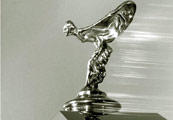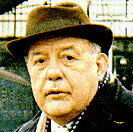London diary : Wednesday 21 September 2005
After breakfasting together, Eileen Ramsay and I took a taxi to Chelsea Manor Street where, at the Cadogan Hall, with four other members of the Romantic Novelists' Association, we were going to spend the day doing a media training course.
Our tutor was a former Member of Parliament, Hugo Summerson, who now runs Speaker Skills Training.
After introducing himself, Hugo presented each of us with a folder containing nine pages of course notes. The morning was spent going through them.
At lunch time, we relaxed over a delicious "cold collation"organised by Jenny Haddon, Chairman of the RNA, whose idea it had been to organise a media training day for Association members.
Hugo drank water with his lunch, but the rest of us drank pink champagne, or wine, to fortify us for an afternoon being interviewed and filmed.
Obviously I am not going to reveal the secrets of successful media interviews which Hugo taught us. But, even though I have been on TV before, during an 8-city tour of the UK for the publication of All My Worldly Goods, and was a little less apprehensive than some of my colleagues, I thought the course was well worth the fee and would recommend it to any writer likely to be caught up in the publicity circus.
It was a salutory experience to watch the videos of our interviews and listen to the comments of our colleagues before striving to improve our performance in a second interview.
For Eileen, Jenny and me, the day ended with an al fresco supper in the forecourt of The Pheasantry, a Georgian building at 152 Kings Road which is now a Pizza Express restaurant. The site was originally used to raise pheasants for the royal household. In the early 1900s, it was the home of Eleanor Thornton, thought to have been the model for The Spirit of Ecstasy mascots on Rolls Royce cars.

In the 1920s and 1930s it housed the studio of the famous dance teacher who taught prima ballerinas Alicia Markova and Margot Fonteyn. Later the building became a well-known artists' colony with which such famous names as Augustus John and Annigoni were associated.

In 1976 the six-year campaign to save The Pheasantry from dereliction reached a peak. Under the patronage of Sir John Betjeman, [whose photo you see on the left] the Friends of The Pheasantry wanted the building restored with residential studios, an art gallery, and exhibition space. They were not successful in preventing the adjoining development, but the front and gateway of the Pheasantry survived, heavily restored, as part of the rebuilding of 1971-81, forming a restaurant hemmed in by shops and offices.
If interested, you can read the story of The Pheasantry in more detail at Wikipedia.
After a excellent supper, and more shop-talk - of which writers, normally shut away on their own, can never get enough - Eileen and I taxied back to the club, feeling a lot more clued up than we had been on the outward journey that morning.

0 Comments:
Post a Comment
<< Home